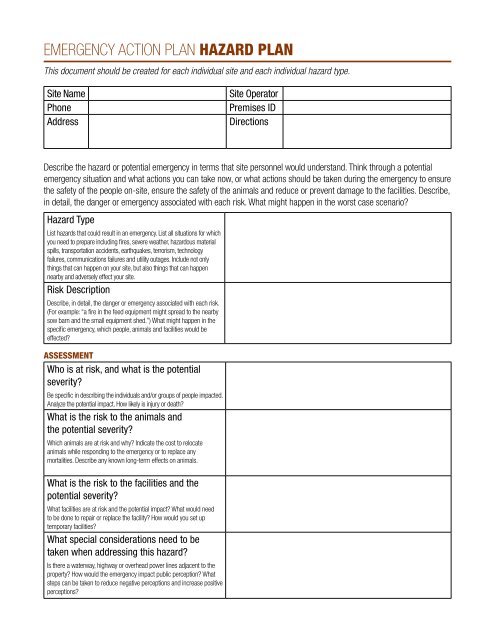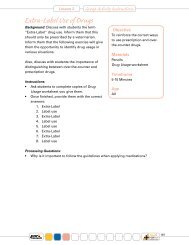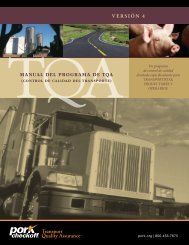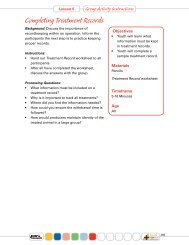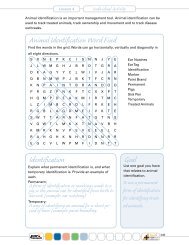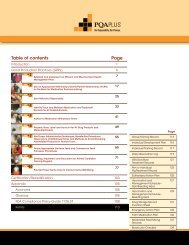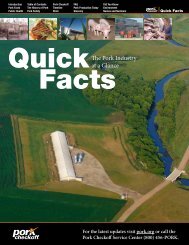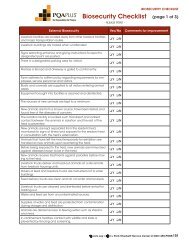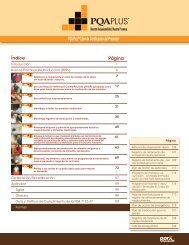EMERGENCY ACTION PLAN HAZARD PLAN
EMERGENCY ACTION PLAN HAZARD PLAN
EMERGENCY ACTION PLAN HAZARD PLAN
Create successful ePaper yourself
Turn your PDF publications into a flip-book with our unique Google optimized e-Paper software.
<strong>EMERGENCY</strong> <strong>ACTION</strong> <strong>PLAN</strong> <strong>HAZARD</strong> <strong>PLAN</strong><br />
This document should be created for each individual site and each individual hazard type.<br />
Site Name<br />
Phone<br />
Address<br />
Site Operator<br />
Premises ID<br />
Directions<br />
Describe the hazard or potential emergency in terms that site personnel would understand. Think through a potential<br />
emergency situation and what actions you can take now, or what actions should be taken during the emergency to ensure<br />
the safety of the people on-site, ensure the safety of the animals and reduce or prevent damage to the facilities. Describe,<br />
in detail, the danger or emergency associated with each risk. What might happen in the worst case scenario?<br />
Hazard Type<br />
List hazards that could result in an emergency. List all situations for which<br />
you need to prepare including fires, severe weather, hazardous material<br />
spills, transportation accidents, earthquakes, terrorism, technology<br />
failures, communications failures and utility outages. Include not only<br />
things that can happen on your site, but also things that can happen<br />
nearby and adversely effect your site.<br />
Risk Description<br />
Describe, in detail, the danger or emergency associated with each risk.<br />
(For example: “a fire in the feed equipment might spread to the nearby<br />
sow barn and the small equipment shed.”) What might happen in the<br />
specific emergency, which people, animals and facilities would be<br />
effected?<br />
ASSESSMENT<br />
Who is at risk, and what is the potential<br />
severity?<br />
Be specific in describing the individuals and/or groups of people impacted.<br />
Analyze the potential impact. How likely is injury or death?<br />
What is the risk to the animals and<br />
the potential severity?<br />
Which animals are at risk and why? Indicate the cost to relocate<br />
animals while responding to the emergency or to replace any<br />
mortalities. Describe any known long-term effects on animals.<br />
What is the risk to the facilities and the<br />
potential severity?<br />
What facilities are at risk and the potential impact? What would need<br />
to be done to repair or replace the facility? How would you set up<br />
temporary facilities?<br />
What special considerations need to be<br />
taken when addressing this hazard?<br />
Is there a waterway, highway or overhead power lines adjacent to the<br />
property? How would the emergency impact public perception? What<br />
steps can be taken to reduce negative perceptions and increase positive<br />
perceptions?
<strong>EMERGENCY</strong> <strong>ACTION</strong> <strong>PLAN</strong> <strong>HAZARD</strong> <strong>PLAN</strong> (page 2)<br />
This document should be created for each individual site and each individual hazard type.<br />
Site Name<br />
<strong>PLAN</strong> OF <strong>ACTION</strong><br />
Who is the lead responder for this hazard,<br />
and what are other personnel roles?<br />
Who is in charge of leading the response effort? What other personnel<br />
would have leadership roles? Be sure to describe, in detail, the lead or<br />
leaders and their roles and responsibilities in case of this emergency.<br />
Who has special skills to respond to this<br />
hazard?<br />
Which people in your operation have skills to deal with this emergency<br />
(i.e. CPR training, trained electrician, heavy equipment operator, etc.)?<br />
List employees that may have knowledge/skills to assist in the case of<br />
an emergency outside of their daily work tasks.<br />
Who will handle public communications?<br />
(i.e. news media, local agencies, general public)<br />
Evacuation plans and posting information.<br />
Should this site be evacuated? If so, how? Be sure to include any<br />
evacuation plan diagrams or images. Where should the evacuation<br />
plans be posted at the site?<br />
Available equipment and resources.<br />
Identify the location of emergency equipment: AED (automatic external<br />
defibrillator), fire extinguishers, telephones, shut-off valves, etc.; or<br />
equipment that could be used to manage an emergency such as farm<br />
machinery, trench digging equipment, ropes, animal handling tools, etc.<br />
Detail the steps to direct, control and<br />
coordinate the emergency response.<br />
List the steps for coordinating the response. Use as much detail as<br />
possible and avoid assumptions. The effectiveness of the response will<br />
depend largely on the amount of thought and detail included in this part<br />
of the plan.<br />
SELF-DIRECTED EVALUATION<br />
Describe the tasks needed to establish and<br />
maintain facility readiness.<br />
What steps are needed to respond to this type of emergency? Describe<br />
how you will evaluate and adjust this plan over time. Who is responsible<br />
for maintenance of the action plan in the event of personnel changes,<br />
site adjustments, etc.?<br />
Training and Education<br />
Describe the training necessary for this emergency. Include the staff<br />
involved, training content, resources available and frequency of training.<br />
You will want to schedule these in the Maintenance and Training Tasks<br />
portion of this plan.<br />
Hazard<br />
Date Updated:<br />
SAVE<br />


